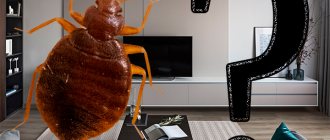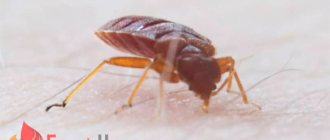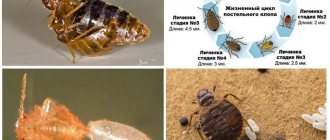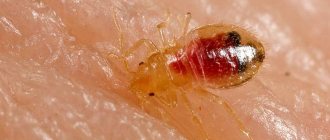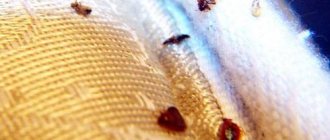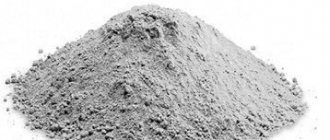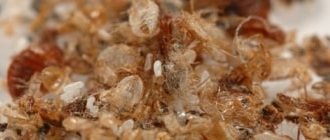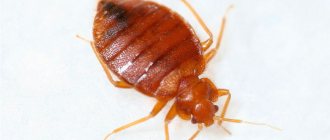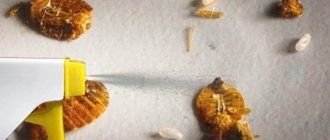Insecticidal preparations for the destruction of parasites in homes began to be actively used in everyday life relatively recently. Just a few decades ago, exclusively folk remedies were used to expel blood-sucking insects, mainly various plants with a pronounced aroma.
It is possible and necessary to use herbs against bedbugs; they act extremely gently, preventing the appearance of parasites in the house and forcing them to leave the home.
They are completely safe for children, adults, pets, and can be used in residential premises for any purpose.
To find out which herbs bedbugs are afraid of and which of them help against parasites in the apartment, it is recommended that you read the following article.
Herbs for bedbugs
Almost any herb that has a pronounced aroma helps against bedbugs in an apartment, but if the room is heavily infested, it is best to use plants whose chemical composition contains substances harmful to parasites.
The list of herbs that bedbugs are especially afraid of includes, for example, tansy, wormwood, wild rosemary. Most blood-sucking insects cannot tolerate the smell of these particular plants.
If the house has been chemically treated with insecticides, you also need to know what grass bed bugs do not like. Preventive treatment of the premises through the use of plants will help prevent the reappearance of parasites.
Herbs such as chamomile and peppermint are excellent at repelling bedbugs. You can collect plants yourself or purchase ready-made raw materials at a pharmacy.
Chamomile
Chamomile is a highly effective and mild herb against bedbugs. It can be used for preventive treatment of premises and the destruction of blood-sucking parasites.
A particularly effective herb for insect control is Dalmatian chamomile. Its composition is enriched with substances that have a detrimental effect on parasites, but are absolutely safe for humans.
Chamomile can be used in a variety of ways. Since domestic bed bugs are afraid of this herb, to prevent the appearance of the latter, you can place small bouquets or dried powder prepared from the inflorescences in the space behind the furniture and ventilation holes.
A saturated decoction prepared at the rate of a handful of herbs per liter of water is recommended to thoroughly rinse the floor, spray furniture and walls, and use when washing home textiles.
Sagebrush
An equally effective herb against blood-sucking parasites is common wormwood. The composition of this plant contains chemical components that have a repellent effect on bedbugs.
In addition, wormwood for bedbugs, spread under the bed or other sleeping place, will help reduce the number of insect bites, even if there are a large number of them in the house.
It is recommended to place bouquets of wormwood under beds and sofas; you can put sachets filled with dried plants in wardrobes. It is recommended to periodically wash the floor with a decoction of the plant, treat ventilation grilles, home textiles, and carpets.
It is especially important to do this after sanitizing the room against bedbugs; this will help prevent the reappearance of uninvited guests.
Tansy
Tansy grass is especially effective at repelling bedbugs; parasites especially do not like this plant, since its composition includes toxic substances. Using tansy will quickly get rid of any number of insects.
To remove them, you should scatter the dried inflorescences of the plant in secluded corners of the apartment, where parasites are especially often localized.
You only need to use dry raw materials; fresh inflorescences contain too many toxic substances that can cause human poisoning.
Important! If there are pets or children in the house, it is imperative to limit their access to tansy inflorescences, as it is extremely poisonous.
Ledum
Ledum herb can be used even if the living space is heavily infested. The composition of this amazing plant includes toxic substances that have a stupefying effect on parasites.
To effectively treat an apartment, it is enough to set fire to dry raw materials and fumigate all rooms with smoke.
After carrying out such a procedure, bedbugs literally fall into a state of deep anabiosis.
To prevent intoxication of the human body, household members and animals should be removed from the home before treating it. In addition, it is important to use a respirator, safety glasses, and gloves. It is also necessary to wear gloves when preparing plant materials, that is, collecting wild rosemary herb.
Video
What repels bedbugs?
Tansy
Another type of plant that can repel bed bugs is tansy. This is a fairly common meadow plant with small yellow flowers collected in clusters of inflorescences. A decoction of tansy is actively used by gardeners and gardeners to treat crops against pests. For many insects, tansy is poison.
However, tansy is unable to destroy bed bugs, since these insects do not eat grass, but feed only on human blood. Of course, if an individual gets into the tansy decoction, it will most likely die.
In this case, a substance poisonous to the insect will enter the insect’s body through the respiratory tract. However, simply inhaling the air in which the smell of tansy is in the air will not kill the insect.
Tansy, like wormwood, acts on bedbugs as a repellent, that is, the grass does not kill blood-sucking insects, but repels them. Thus, the herb helps provide household members with a restful sleep at night for some time.
How do herbs act on bedbugs?
There are a lot of plants that have a repellent effect on blood-sucking parasites, but only a small number of them have a detrimental effect on insects. For example, wild rosemary and tansy have insecticidal properties.
These herbs for bedbugs, which contain toxic substances, destroy adult bedbugs, but do not affect the condition of the eggs.
The remaining plants can be used exclusively for preventive treatment of the premises or as an additional measure during pest control procedures.
Essential oils, which are components of most natural raw materials, will help protect your home for a long time from the invasion of uninvited guests.
Chemistry
This category includes turpentine, vinegar, kerosene, denatured alcohol, acetone and some other chemicals that have a pungent, unpleasant odor. They do not get rid of insects, but they can be reliable repellents, provided that you yourself are willing to put up with the strong smell of chemicals.
Everything that bed bugs fear can be successfully used against them. However, we note that all these methods are more suitable to complement the main treatment aimed at killing bedbugs.
Advantages and disadvantages
The use of medicinal herbs as an antiparasitic agent has a wide range of advantages, but some disadvantages can be identified.
The main advantages of using herbs are:
- For preventive treatment of the room, you can use chamomile and lavender. The strong smell of these plants will help repel bedbugs, while being very pleasant to humans. The presence of such herbs will help give the room a particularly pleasant atmosphere.
- Natural components act especially gently, without having an aggressive negative effect on the human condition, such as, for example, various insecticidal agents, which are based on chemical toxic substances. You can use natural raw materials even in a house where small children live.
- Before processing the room, there is no need for lengthy preparatory measures; it is enough to just carry out wet cleaning and wash the floor.
- Most insecticides are expensive, but using natural raw materials will help avoid significant material costs.
As for the disadvantages, these include the low effectiveness of herbs; most of them only repel parasites without having a harmful effect on them.
In addition, when treating a room, you can only get rid of adult insects; unpleasant odors do not have any effect on the eggs.
The disadvantages also include some danger posed by certain types of plants, for example, wild rosemary and tansy. Inhalation of vapors from fresh inflorescences by a person can cause severe intoxication of the body, suffocation, coughing, and acute headache.
Persons with children or pets should use such products with particular caution.
Marsh wild rosemary
When listing plants that help fight against domestic parasites, one cannot fail to mention wild rosemary. It is an aromatic evergreen grass that grows in marshy areas. The leaves and flowers of wild rosemary contain a certain combination of essential oils, and their share in the herb is 7-8% of the total mass.
It is the presence of oils that gives wild rosemary such a bright and intoxicating aroma. The smell of this plant is quite pleasant for humans, but if you spend a long time in wild rosemary thickets, you can feel dizzy, drowsy, and headache. In the fight against parasites, wild rosemary can be used in different forms:
- Decoction. Used for spraying sofas and other likely habitats of parasites;
- Powder made from dried leaves and shoots. They are used as a dust, that is, they are scattered in the habitats of insects and in places where they move;
- Smoke. Fumigation of premises by burning dry leaves and stems of wild rosemary has a fairly effective effect.
Popular questions
What grass are house bugs especially afraid of? Tansy and wormwood have strong repellent properties. A small amount of dry raw materials, spread out for prevention, will help avoid the appearance of parasites.
Are herbs safe for human health? Tansy and wild rosemary may pose some danger to people. The composition of these plants includes toxic substances. To prevent poisoning, when treating a room it is important to wear a protective mask and gloves.
How many times should the premises be treated? Any herbs have a detrimental effect only on adult parasites. In order to destroy insects that appear from eggs preserved after the first treatment, it is necessary to repeat the procedure after at least two weeks.
Valerian
A product from the “two in one” category. Firstly, it acts as a fairly powerful natural insecticide and “antiseptic”, repelling bed bugs with its characteristic odor and helping to get rid of the pathogens of the diseases they carry.
Secondly, valerian has a beneficial effect on the nervous system of a person, who inevitably experiences severe psychological discomfort and stress due to daily repeated “encounters” with insects at night and chronic lack of sleep. It helps to quickly restore peace of mind.
Valerian in the form of an alcohol tincture is used both to prevent the “migration” of bed bugs from neighboring apartments and to combat them. The entire room needs to be treated, paying special attention to potential “paths of entry” into the house: ventilation ducts, any gaps and cracks in the walls, windows, entrance doors, baseboards.
Furniture must be sprayed with legs, bottom, as well as all places suitable for nesting - drawers, hard-to-reach areas of the frame. We must not forget about the mattress and bedding.
The treatment is repeated daily or every other day for 1-2 weeks. After this, leave the room for 1-2 hours, then thoroughly ventilate.
Important! When choosing valerian as a means of combating bed bugs, you need to take into account the specific reaction of cats to it. If it is not possible to temporarily “rehome” your pets, it is better to look for other options.
Temperature difference
Most of all, bedbugs are afraid of temperature changes. The favorable temperature for their habitat is above zero, reaching 20-30 °C. Lowering it by 10-15 degrees has a bad effect on their reproduction. If they are poisoned in this way for a long time, the bloodsuckers will leave and find other owners where they will feel comfortable. In winter, you can open the windows in your apartment for 2-3 days so that bedbugs leave your home. Temporary ventilation will not help.
The methods listed above repel bloodsuckers, but will not help get rid of them forever. Therefore, the best option is to contact special services that will carry out disinfestation, or purchase effective means for killing bedbugs.
Effective chemicals
Dichlorvos
The same remedies are used against bed bugs as against flies, mosquitoes, cockroaches and large “house” ants. They are available in the form of powders, gels, emulsions, aerosols and crayons. Most of the drugs presented on the modern consumer market are safe for people and pets. The innovative composition does not contain components harmful to humans, so some chemicals can be safely used by pet owners and families with children.
Note! Aerosols actively fight insects by repelling them. The pungent odor is sometimes unpleasant for humans, so not everyone who faces the problem prefers Dichlorvos or Antiklop.
When working with any chemicals, you should pay attention to the composition and attached instructions. The instructions for use describe the safety precautions and methods of use that must be followed.
Among the popular products are the following products: “Clean House”, “Raptor”, “Klopoveron”, “Mashenka”, “Fas” and “Fumitox”.
Turpentine
A remedy that gives a guaranteed effect, but is not very popular, used as a “last resort”. The problem is its intense smell - it is completely impossible for people to stay indoors after treatment and even unsafe for health.
After such an “aroma attack,” bedbugs also leave the house or apartment within 24 hours. Turpentine not only negatively affects their sense of smell, but also “dissolves” the chitinous membranes.
The solution is prepared in advance by adding 10 ml of turpentine, 15 ml of kerosene and about 40 g of fine soap shavings to 100 ml of water. It needs to be allowed to brew for at least 4-5 hours so that all the components “combine”.
All identified and hypothetical habitats of bedbugs are sprayed with the liquid. Then they close the windows and doors tightly and leave for the day. After 7-10 days, it is advisable to repeat the treatment in order to get rid of individuals that during this time managed to hatch from possibly retaining the viability of the eggs.
The final stage: cleaning up the consequences of disinfestation
After treatment, the room must be ventilated
- In addition to mandatory ventilation, all surfaces are cleaned from residues of the sprayed product. It is wiped off on all surfaces, and carpets and furniture are vacuumed to remove dead insects.
- Coverings, curtains, and covers used to protect surfaces are washable.
- For wet cleaning, use baking soda and liquid soap in solution.
- Things are laid out on dry surfaces, dishes are placed, etc.
- Disinfection of the premises is repeated after 7 days to destroy insects and bedbugs that have emerged from the eggs by this time and were not subject to the initial influence of the drug.
How to clean an apartment after using pesticides?
In this article, we have fully described which pesticides are included in each product in the Clean House line of bed bug exterminators, but if you use other chemical insect exterminators, it will be useful for you to familiarize yourself with the tips below.
If you don't know what pesticides were used, start by looking at the ingredients on the product label. Understand what ingredients are in your home and how they interact with your carpets, linoleum, or woodwork.
Until you know what pesticides were used, do not attempt any cleaning method without consulting a professional. Some pesticides can react poorly with acids, and some pesticides even react with water. Try to obtain technical advice and evaluation for the specific product, including toxicity and persistence.
There are no standard cleaning procedures for removing unwanted pesticide residues and there are many potential hazards to avoid. Consider hiring a professional to clean your home, especially if you have misused or overused pesticides in your home.
Treating premises with Clean House spray
After cleaning the house, having carefully examined all the surrounding space, you should move all the cabinets away from the walls. It is important to treat not only the outside but also the inside. Armchairs and sofas should also be disassembled so that they do not interfere with processing.
First, shake the can to mix its contents. After this, you can start spraying all important places, such as baseboards, corners, wallpaper, and so on. Do this at arm's length so that the spray does not get into your vital organs. For one square meter, 5 seconds of spray treatment is enough.
Important! If you have the opportunity to leave your home for at least 3 days, then at the very end you can spray the aerosol directly into the air, in the center of the room.
Place of sale
Unfortunately, it will be difficult to find chamomile in pharmacies and specialized outlets. It is ideal to prepare the powder yourself, but we all understand that this takes time.
It is possible to order in online stores, or give preference to the usual medicinal one, but you should take into account the low concentration of poison. Some people use the drug and add naphthalene to it.

